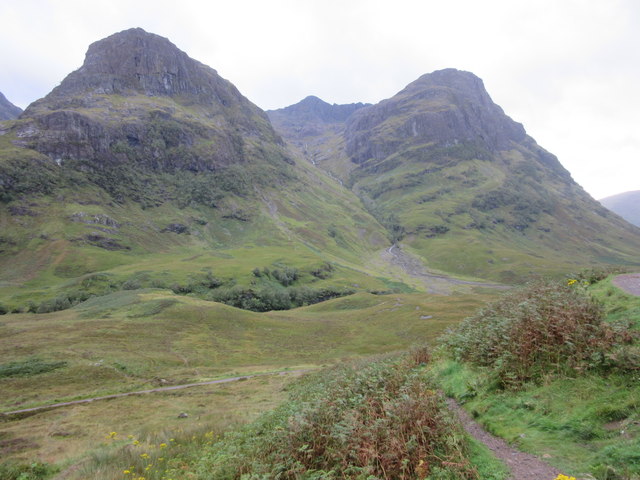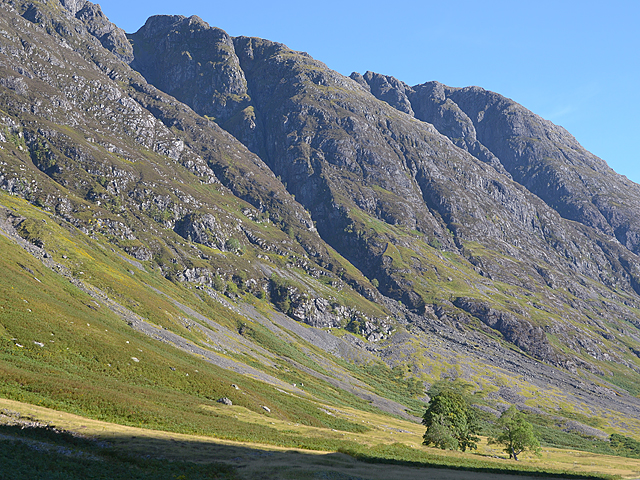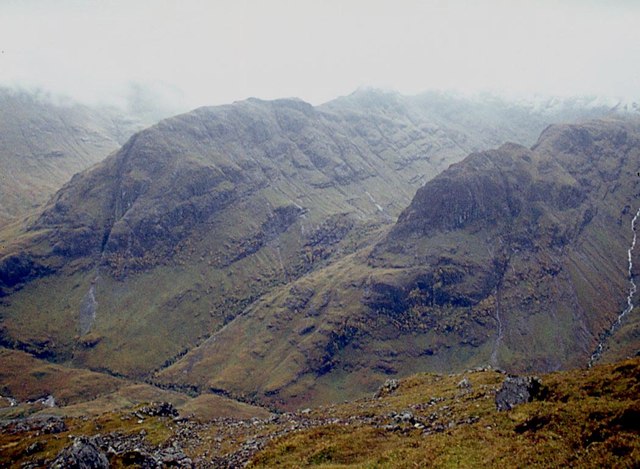Am Bodach
Hill, Mountain in Argyllshire
Scotland
Am Bodach

Am Bodach is a prominent hill located in Argyllshire, Scotland. Situated in the southern part of the county, it forms part of the Mamores range, which is renowned for its stunning natural beauty and challenging hikes. The hill stands at an impressive height of 1,034 meters (3,392 feet), making it one of the prominent peaks in the area.
Am Bodach is characterized by its distinctive pyramid-shaped summit, which offers breathtaking panoramic views of the surrounding landscape. On a clear day, visitors can enjoy vistas of Loch Leven, Loch Linnhe, and the nearby peaks of the Mamores range. The hill is surrounded by rugged terrain, with steep slopes and rocky outcrops, making it a popular destination for experienced hikers and mountaineers.
The ascent of Am Bodach is typically approached from the Kinlochleven side, where a well-defined path leads climbers up the mountain. The hike is considered challenging, with sections of scrambling required near the summit. However, the rewarding views and sense of accomplishment make it a worthwhile endeavor for outdoor enthusiasts.
The hill is also known for its rich biodiversity, with a variety of plant and animal species thriving in its diverse habitats. Visitors may spot native wildlife such as red deer, mountain hares, and golden eagles during their ascent.
Overall, Am Bodach offers a thrilling outdoor experience for those seeking adventure and natural beauty. Its imposing presence, stunning views, and challenging terrain make it a popular destination for hillwalkers and mountaineers in Argyllshire.
If you have any feedback on the listing, please let us know in the comments section below.
Am Bodach Images
Images are sourced within 2km of 56.677921/-4.9914355 or Grid Reference NN1658. Thanks to Geograph Open Source API. All images are credited.




Am Bodach is located at Grid Ref: NN1658 (Lat: 56.677921, Lng: -4.9914355)
Unitary Authority: Highland
Police Authority: Highlands and Islands
What 3 Words
///changed.reactions.hampers. Near Glencoe, Highland
Nearby Locations
Related Wikis
Glen Coe
Glen Coe (Scottish Gaelic: Gleann Comhann pronounced [klan̪ˠˈkʰo.ən̪ˠ]) is a glen of volcanic origins, in the Highlands of Scotland. It lies in the north...
Meeting of Three Waters
Meeting of Three Waters is a waterfall of Scotland.The waterfall is situated at the foot of the Three Sisters of Glen Coe - a popular hiking and skiing...
Coire Gabhail
Coire Gabhail (Corrie of the Bounty, or The Hollow of Capture) is a high level glen in the Bidean nam Bian mountain massif to the south of Glen Coe, Highland...
Aonach Eagach
The Aonach Eagach (Scottish Gaelic for 'notched ridge') is a large mountain ridge in the Scottish Highlands, marking the northern edge of Glen Coe. It...
Loch Achtriochtan
Loch Achtriochtan or Loch Trychardan is a small shallow freshwater loch located to the east of Glencoe village in Lochaber in the Scottish Highlands. It...
Kinlochleven
Kinlochleven () (Scottish Gaelic: Ceann Loch Lìobhann) is a village located in Lochaber, in the Scottish Highlands and lies at the eastern end of Loch...
Clachaig Inn
The Clachaig Inn is a hotel and pub in Glen Coe, Lochaber, Highland, Scotland. It is popular with walkers and climbers who come to visit the surrounding...
Pap of Glencoe
The Pap of Glencoe (Scottish Gaelic: Sgorr na Cìche) is a mountain on the northern side of Glen Coe, in the Highlands of Scotland. It lies at the western...
Nearby Amenities
Located within 500m of 56.677921,-4.9914355Have you been to Am Bodach?
Leave your review of Am Bodach below (or comments, questions and feedback).




















